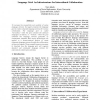Free Online Productivity Tools
i2Speak
i2Symbol
i2OCR
iTex2Img
iWeb2Print
iWeb2Shot
i2Type
iPdf2Split
iPdf2Merge
i2Bopomofo
i2Arabic
i2Style
i2Image
i2PDF
iLatex2Rtf
Sci2ools
SAINT
2006
IEEE
2006
IEEE
Language Grid: An Infrastructure for Intercultural Collaboration
To increase the accessibility and usability of online language services, this paper proposes the language grid to create composite language services for various communities. The language grid is called “horizontal,” when the grid connects the standard languages of nations, or “vertical,” when the grid combines the language services generated by communities. Semantic Web service technologies are applied in a human-centered fashion, to create composite language services through the collaboration of users and agents. Three example scenarios are given to illustrate how the language grid will organize standard and community language services for intercultural collaboration activities.
Composite Language Services | Internet Technology | Language Grid | Language Services | SAINT 2006 |
| Added | 12 Jun 2010 |
| Updated | 12 Jun 2010 |
| Type | Conference |
| Year | 2006 |
| Where | SAINT |
| Authors | Toru Ishida |
Comments (0)

